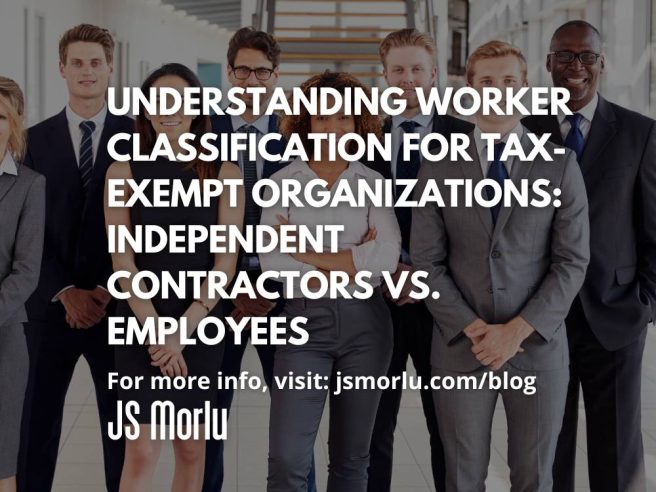By: John S. Morlu II, CPA
Tax-exempt organizations (EOs) must accurately classify workers as either employees or independent contractors. This classification affects tax obligations, reporting requirements, and legal responsibilities. Misclassification can lead to costly consequences, including back taxes, penalties, and interest.
Types of Worker Classifications
The IRS recognizes four categories of workers:
1. Independent Contractor:
- An individual who operates as a self-employed entity, controlling how and when they perform their work.
- Example: A freelance graphic designer contracted to create marketing materials for an EO.
2. Common-Law Employee:
- A worker whose job duties and the way they are performed are directed or controlled by the EO.
- Example: A program coordinator hired to work regular hours and perform tasks under the EO’s direct supervision.
3. Statutory Employee:
- Certain workers classified as employees by statute, even if they meet some independent contractor criteria.
- Example: Certain salespeople or insurance agents under specific circumstances.
4. Statutory Non-Employee:
- Workers treated as self-employed by statute, regardless of the level of control exercised by the organization.
- Example: Direct sellers or licensed real estate agents.
Key Factors for Worker Classification
To classify a worker, the IRS uses the Common-Law Test, which evaluates the level of control and independence in the working relationship. The test examines three categories:
1. Behavioral Control:
- Does the EO dictate how, when, and where the work is performed?
- Examples of behavioral control:
o Providing detailed instructions on how tasks should be completed.
o Requiring specific training for the worker.
2. Financial Control:
- Does the EO control the business aspects of the worker’s role?
- Considerations include:
o Whether the worker has unreimbursed business expenses.
o Whether the worker has a significant investment in tools or equipment.
o How the worker is paid (e.g., hourly vs. per project).
o Whether the worker can realize a profit or loss.
3. Relationship of the Parties:
- Are there written contracts or employee benefits, such as insurance or paid time off?
- Key indicators:
o Permanency of the relationship (e.g., ongoing employment suggests an employee).
o Nature of services provided (e.g., if they are key to the EO’s operations).
Responsibilities for Tax-Exempt Organizations
Once the worker’s classification is determined, EOs must fulfill the following obligations:
For Employees:
- Withholding Taxes:
o Federal income tax.
o Social Security and Medicare taxes (FICA). - Employer Taxes:
o The EO must pay the employer’s portion of FICA taxes.
o Federal unemployment tax (FUTA) in most cases. - Reporting:
o Wages must be reported annually on Form W-2.
For Independent Contractors:
- No Withholding:
o EOs are not responsible for withholding taxes on payments made to contractors. - Reporting Requirements:
o Payments of $600 or more to contractors must be reported on Form 1099-NEC.
Risks of Misclassification
Misclassifying an employee as an independent contractor can have serious consequences for the EO, including:
- Liability for unpaid employment taxes.
- Penalties for failure to file correct forms.
- Interest on unpaid taxes.
For example, if an EO incorrectly classifies a full-time worker as an independent contractor and fails to withhold taxes, the organization may be required to pay those taxes, plus interest and penalties.
Additional IRS Resources for Worker Classification
Tax-exempt organizations can access the following IRS publications for detailed guidance:
1. Publication 15-A (Employer’s Supplemental Tax Guide):
Provides an in-depth explanation of who qualifies as an employee under common-law rules.
2. Publication 1779 (Independent Contractor or Employee?):
Offers a quick reference for distinguishing between employees and contractors.
3. Form SS-8 (Determination of Worker Status for Purposes of Federal Employment Taxes and Income Tax Withholding):
Allows organizations to request a formal determination of worker classification from the IRS.
4. Employment Taxes Resources for Exempt Organizations:
A comprehensive guide for EOs on their employment tax responsibilities.
Best Practices for Tax-Exempt Organizations
1. Document the Relationship:
- Maintain written agreements specifying the terms of the working relationship.
- Include details about payment structure, scope of work, and expected independence.
2. Review Worker Roles Regularly:
- Periodically evaluate whether the worker’s role has changed, necessitating reclassification.
3. Seek Professional Advice:
- Consult a tax professional or attorney if there is uncertainty about worker classification.
By following these guidelines and leveraging available IRS resources, tax-exempt organizations can ensure compliance with tax laws, avoid penalties, and foster fair working relationships.
Author: John S. Morlu II, CPA
John S. Morlu II, CPA, is the CEO and Chief Strategist of JS Morlu, a globally acclaimed public accounting and management consulting powerhouse. With his visionary leadership, JS Morlu has redefined industries, pioneering cutting-edge technologies across B2B, B2C, P2P, and B2G landscapes.
The firm’s groundbreaking innovations include:
• ReckSoft (www.ReckSoft.com): AI-driven reconciliation software revolutionizing financial accuracy and efficiency.
• FinovatePro (www.FinovatePro.com): Advanced cloud accounting solutions empowering businesses to thrive in the digital age.
• Fixaars (www.fixaars.com): A global handyman platform reshaping service delivery and setting new benchmarks in convenience and reliability.
Under his strategic vision, JS Morlu continues to set the gold standard for technological excellence, efficiency, and transformative solutions.
JS Morlu LLC is a top-tier accounting firm based in Woodbridge, Virginia, with a team of highly experienced and qualified CPAs and business advisors. We are dedicated to providing comprehensive accounting, tax, and business advisory services to clients throughout the Washington, D.C. Metro Area and the surrounding regions. With over a decade of experience, we have cultivated a deep understanding of our clients’ needs and aspirations. We recognize that our clients seek more than just value-added accounting services; they seek a trusted partner who can guide them towards achieving their business goals and personal financial well-being.
Talk to us || What our clients says about us





